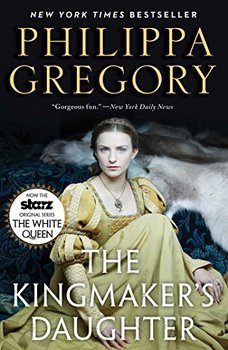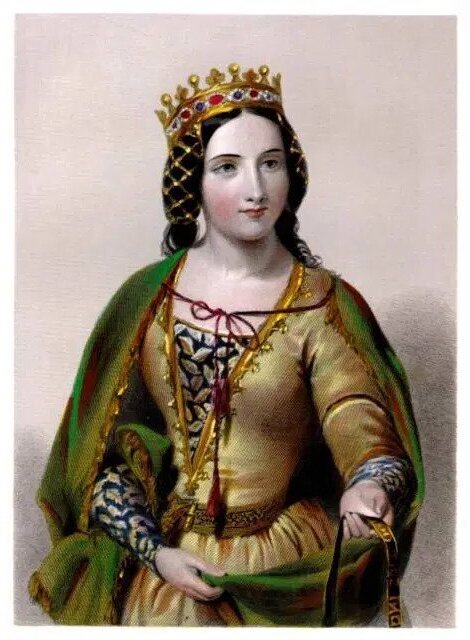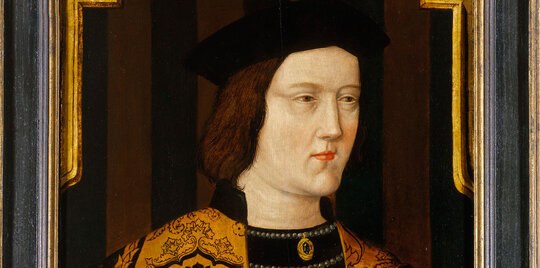
She was the second daughter of the richest and most powerful man in England, more mighty than the king himself. He was Richard Neville, my namesake, known throughout the land as “Warwick the Kingmaker.” And during her childhood, he deposed one king and placed another on the throne. It was all part of his life-long obsession to secure the throne for Anne Neville or her older sister Isabel as Queen of England. Philippa Gregory’s engaging historical novel, The Kingmaker’s Daughter, tells Anne’s tale in her own words from her childhood to the pinnacle of glory when still a young woman less than twenty years later. It’s a story that starkly illustrates the reality that, in late medieval England, there was nothing noble about the nobility.
Estimated reading time: 7 minutes
A troubled life in a tumultuous time
Anne Neville (1456-85) is nine years old as the novel opens in 1465 and still shy of thirty when the story concludes shortly before her death. She narrates the turbulent events of the interceding years, infusing the tale with all the wonder and fear and astonishment she might well have felt along the way. Her flight across the Channel amid a terrible storm. The death of her father in battle. The constant fear of witchcraft. Her sister’s death, probably by murder. The on-again, off-again reign of Edward IV. Her great love for Richard, who becomes her husband. It’s all there. The chronology may be a little scrambled, but this account of one of the most tumultuous times in England’s always eventful history leaps off the page.
The Kingmaker’s Daughter (Plantagenet & Tudor Novels #4) by Philippa Gregory (2012) 434 pages ★★★★☆

Plantagenets? Tudors? Who were these people?
Without at least a superficial knowledge of the convoluted family relations that bedeviled royal politics in fifteenth-century England, much of the events in The Kingmaker’s Daughter may be confusing, at best. So, here’s a crude attempt to sort through a few of the basics.
Plantagenets
The House of Plantagenet was a French royal family that ruled England from 1154 until the death of King Richard III at the Battle of Bosworth Field in 1485. The events in The Kingmaker’s Daughter unfold during the last twenty years of the Plantagenets’ reign. But to say the family ruled throughout that period misses the point, because the Plantagenets were hardly a single family. There were several branches of the clan, and they hated each other. As I say, there was nothing noble about the nobility.
Lancaster and York
The houses of Lancaster and York were cadet branches of the sprawling Plantagenet family. The rivalry between them brought about the Wars of the Roses (1455-87), a decades-long fight for the English succession, culminating in 1485 at the Battle of Bosworth Field. They were all cousins, and they seemed to enjoy little more than scheming against one another and turning to murder when their plots fell flat (or even when they succeeded).
The Tudors
The House of Tudor, more familiar to most non-English readers, ascended to the throne with the final defeat of the Yorkist forces at Bosworth Field. Henry Tudor, of the Lancastrian line, took the throne as Henry VII. He was followed by his son, Henry VIII, and he in turn years later by his daughter Elizabeth I. When she died childless in 1603, the crown passed from out of the hands of the Tudors.

Principal characters in the novel
Many, but not all, of the principal characters in The Kingmaker’s Daughter were members of one or another of the Plantagenet families.
- Richard Neville, Earl of Warwick, (1428-71) was known as “the Kingmaker,” and Philippa Gregory explains why in lurid detail in the novel.
- Anne Neville, the eponymous Kingmaker’s daughter, narrates the story. She has a bright and terrible future, but I’ll leave it to you to learn about it by reading the book.
- Edward IV of the House of York reigned from 1461 to 1470 and from 1471 to 1483.
- Edward’s wife, Elizabeth Woodville (1437-92), came from a family of gentry and scandalized the court for her lack of royal blood. She bore Edward fourteen children, but it did her little good when her husband was deposed from the throne by his brother.
- King Edward’s two brothers, Richard and George, both made dukes after Edward’s accession, play central roles in the novel. Richard marries Anne Neville and George, Anne’s sister Isabel.
So, what was England really like in the fifteenth century?
There was little that was noble about the nobility
Jettison any romantic notions you may harbor about life in fifteenth-century England. It was a dreadful time, and there was little that was noble about the nobility who populate this novel. Some of the salient facts emerge clearly in Philippa Gregory’s writing. But you have to read between the lines, or research the history yourself, to gain a more accurate picture of the time.
Poor people beset by illness, with death always around the corner
England’s population had fallen to 1.9 million by 1450, continuing a trend in place since the Black Plague a century earlier, when it was nearly five million. The plague was endemic, erupting from time to time. Meanwhile, dysentery (‘the flux’), tuberculosis, arthritis, and ‘sweating sickness’ (probably influenza) killed just as surely. Infant mortality was staggeringly high: around half of all children born died by the age of five. For the average person, life expectancy at birth was about thirty.
Existing on the periphery of human civilization
By global standards, England in the mid-fifteenth century was desperately poor, just barely eking out an existence on the periphery of human civilization. More than half the world’s wealth was concentrated in China (population 100 million) and India (80 million). While the Portuguese were beginning to explore the western coast of Africa on their way to India, the English were fighting one another and fending off hostile Scottish and Welsh tribes from north and west. England was a backwater, of interest to anyone other than English historians now only because of the spectacular accomplishments of the nation under Queen Elizabeth I and her successors.
Taking liberties with history
Philippa Gregory takes liberties with history, for the most part in minor ways. But in one major respect she bends the record. Anne’s husband, Richard of Gloucester, was neither the handsome man she writes about nor a kind and gentle soul. He was physically deformed, and contemporary portraits show the face of a gaunt and decidedly unpleasant man—which apparently he was. In general, however, the author hews to the historical facts.
About the author

The Kingmaker’s Daughter is the fourth book in Philippa Gregory‘s series of fifteen Plantagenet & Tudor Novels published from 2001 to 2017. She has also written thirteen other novels as well as six works of children’s fiction, a collection of short stories, and a nonfiction account of the Cousins’ Wars.
For related reading
I’ve also two other books in this series:
- The White Queen – Plantagenet & Tudor Novels #2 (Viewing English history as tragedy through the life of a queen)
- The Other Boleyn Girl – Plantagenet and Tudor Novels #9 (She might have married Henry VIII. Her sister did.)
You might also be interested in:
- 20 most enlightening historical novels
- 20 top nonfiction books about history
- Top 10 historical mysteries and thrillers
And you can always find my most popular reviews, and the most recent ones, on the Home Page.


























